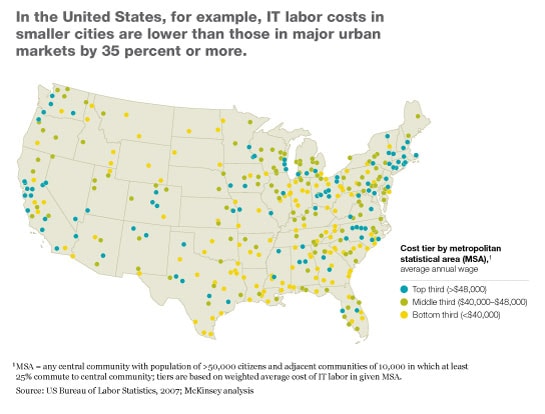Despite the steady march of IT services to offshore centers from India to Russia over the past 15 years, many IT tasks aren’t easily moved. Financial regulations, for instance, often demand that data such as bank records be processed in home markets. Privacy rules impose similar restrictions on health care data, while security guidelines require defense contractors to handle data analysis within national markets. By one estimate, more than 15 percent of data center jobs must remain there for these reasons.1 Even with work that’s not bound by such regulations, it isn’t uncommon for up to 25 percent of all IT service tasks to remain in onshore or at least close-shore locations (close to the home market, though not necessarily in it), simply because that’s where skilled software technicians are found or can be quickly deployed. (For simplicity’s sake, from now on, we shall refer to locations in or near the home market as close-shore locations.)
But as companies review their IT needs going forward, there’s a growing problem with this picture. The onshore service facilities of many companies are located in areas where IT costs are among the highest in the world—often near headquarters operations in major European and North American urban centers. An increasing number of these organizations are now taking a close look at second-tier cities in close-shore locales as venues for future investments. Pools of high-level IT talent are available in such regions, wage levels are attractive, and generous government incentives are often available to spur local investment.
Catalysts driving the emergence of close-shore locations
We have studied wage costs, as well as the breadth and depth of talent pools, for a number of second-tier markets across Europe and North America. Our research shows consistent wage differentials of 30 percent or more between the most central urban IT labor markets and those farther afield. In Europe, for example, we have found that northern France and much of eastern Germany offer attractive lower-cost alternatives for IT investment. In the United States, we have looked at smaller cities in the Great Plains, the South, and the Appalachian states (exhibit).

Beyond lower wages, these regions offer skilled engineers in specialized areas where demand is high, such as infrastructure management or application development and maintenance for new and legacy IT systems. Regional universities and community colleges have markedly expanded their IT curricula in these very areas, and many universities are forging partnerships with employers to guarantee supplies of talent for future needs. Federal, state, and local authorities, eager to reduce regional pockets of unemployment by attracting skilled jobs and IT investments, are offering incentives such as training grants, tax abatements, and subsidized loans.
Adding impetus to the broader close-shore investment trend is the fact that some organizations find themselves under pressure to diversify their portfolios of global IT service facilities. Many companies are heavily weighted in just one or two offshore regions, which exposes those companies to inflationary pressures, currency volatility, and operational risks. In 2008, for example, India’s inflation rate rose to 11 percent, while the rupee’s value against the euro and the dollar fluctuated by 20 to 30 percent.
Finally, for a small subset of skills—ranging from legacy to very high-end ones (such as subject matter expertise and senior-level system administration jobs)—companies are opting to develop and retain the work in low-cost close-shore locations. This development is driven by the ability to procure and develop these scarcer skills in locations where a regular supply of them is available, and at a cost-competitive price relative to offshore locations.
Choosing a close-shore location
Before making significant investment decisions, companies should study their global requirements closely. In our experience, the way to reap competitive advantages through close-shoring is to segment the IT labor force by broad areas of talent needs (for instance, managing mainframes), skill classes (for example, levels of system support), and experience (three to five years of experience versus entry level).
One company’s approach
Many large corporations with substantial IT service operations are studying their close-shore options. One global company’s approach is instructive.
This company’s major IT service facility was located near a large US city where wage costs for IT service personnel were at the top end of the global wage scale. To meet future business needs, the company would have to expand its IT capacity, but since it had large contracts with state and local governments, as well as with health care providers, many IT operations had to remain onshore. Leaders from IT, human resources, government affairs, and strategy formed a task force to decide whether a move to a new close-shore site would produce significant savings while maintaining or bettering current service levels.
The CIO launched the process by taking inventory of the company’s existing global IT workforce by job type, skill level, and wage cost. He then estimated his future needs and costs over a five-year time horizon. Using this analysis, the task force concluded that a new close-shore investment could be beneficial. After reviewing an initial list of 50 cities in the US Midwest and South, the task force selected five as prime locations: places where wage rates were at least 30 percent lower than those of the current US facility and where the local pool of IT engineers would meet projected growth needs.
On several occasions, the task force met with regional officials to discuss incentives such as interest-free loans and tax holidays. In fact, the discussions even explored the possibility of long-term electricity contracts at favorable rates to power the company’s data operations. The task force also met with local university officials to talk about tailoring courses and cooperative programs to ensure a pipeline of qualified new hires. Ultimately, the company decided on a Midwest location, and within a year it had built a new IT center with more than 1,000 IT service employees. Wage rates are 35 percent lower than those at the headquarters location, and the company received $50 million in state and local grants and tax cuts to cover training and start-up expenses.
Other companies report similar benefits from recent close-shore investments. One global IT security organization achieved labor savings of 40 percent by opening a center in the US South, where it found what a division president described as a “high-quality workforce.” A leading software company established a new facility in the upper Midwest, benefiting both from lower wages rates for software-development skills and ten years of tax incentives. After a global IT service provider found that labor constraints made it impossible to expand a low-cost Eastern European operation, the company realized cost savings of almost 30 percent (versus higher-cost regions near its German headquarters) in eastern Germany, where it could also benefit from the technical skills of graduates of more than 60 universities.
The first-mover advantage
It’s important for companies planning similar moves to consider acting rapidly. Our studies show that a metropolitan area with a population under 200,000 can accommodate only one or two large IT centers before supply constraints drive up wages. One IT service provider, for example, had initially decided to locate a new center in a northern Midwest city but backed away after discovering that another company, whose aggressive hiring plans would tap out a local university’s stream of IT graduates, had recently located there. And though tax and other government incentives are relatively plentiful at present, the dollar amounts are often capped, while rising budgetary pressures could change the availability of funding in some regions.
The large global IT service market will continue to grow, and companies should go on taking full advantage of established offshore centers for many needs. Yet our experience from working with a number of clients around the world demonstrates that successful companies are beginning to adopt a hybrid approach. Today, they are starting to use both close-shore locations, when targeted (or legacy) skills are needed to deliver restricted work or to meet high customer requirements, and large offshore centers, when the most pressing necessity is low costs.
To achieve these benefits, companies should consider adopting a granular approach when analyzing and determining their IT service requirements. Our experience helping clients reach such strategic decisions suggests that granularity is needed to make them sustainable and must be modeled at the right level of skill sets. Furthermore, close-shore locations should be evaluated with appropriate readiness criteria to ensure that the options are economically and operationally viable over a five-year horizon. Finally, acting swiftly is important, since significant first-mover advantages exist in many close-shore areas.

